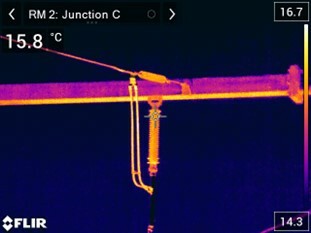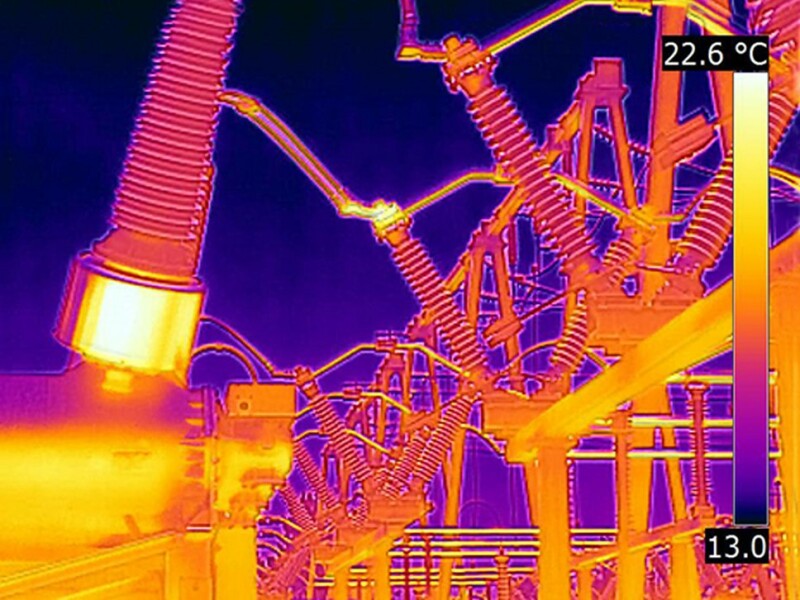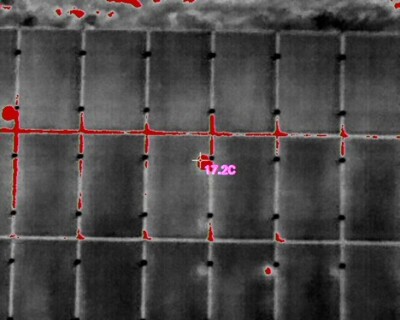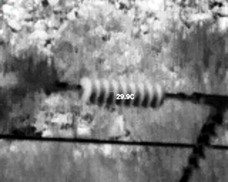There are several variables to consider when measuring temperatures with drone-mounted thermal cameras. The first factor is “emissivity,” or the efficiency with which something gives off its thermal energy
Another important factor is “reflectivity,” or the degree to which an object reflects the thermal energy around it, are the primary variables we have to consider. These are primarily determined by what a material is made of and its surface condition.
But emissivity and reflectivity don’t just impact how relatively hot or cold things look, they also determine whether your temperature measurements are accurate. Adjustments must be made in the drone camera’s settings to get accurate temperature measurements.


Radiometric Thermal Cameras: Apparen vs. True Temperature
All thermal cameras are technically radiometers, according to Greg Nagler, Global Business Development Director sUAS at Teledyne FLIR. “They’re sensitive to varying intensities of radiation, but radiometric cameras take that a step further thanks to the factory calibration process they go through.”
During the build process, Nagler explained, “they’re pointed at a series of radiation sources. Each of these sources, called blackbodies, are set to produce an amount of energy that corresponds to a specific temperature. Each of these sources are programmed into the camera creating what’s called a calibration curve. This is the internal reference the camera uses as the basis for its temperature calculations.”
When working with a calibrated, radiometric camera, operators must understand apparent temperature and true temperature measurement. An apparent temperature is an uncompensated temperature reading, meaning that correct values for emissivity and reflected apparent temperature are left at default values (typically the emissivity is set at 1.0 or .95, and the reflected apparent temperature is left at 20C or 68F). These apparent temperature values have little to no relationship to the object’s actual temperature. They might be close, but they could just as easily be off by hundreds of degrees.
A true temperature, on the other hand, is one where the operator has compensated for emissivity, reflected apparent temperature, and—if possible—atmospheric impacts. If these factors are changed in the camera’s menu, the temperature readings you see on screen should be within the camera’s accuracy specification.
How do you know the emissivity of a material? “The best way, though the most complicated method, is to measure an object’s emissivity by comparing your object to another that has a known emissivity and is at the same temperature,” Nagler said. “Knowing how to do this is one of the main reasons people take thermography certification courses at the Infrared Training Center (ITC). The other way is to look up materials on an emissivity table. These are widely published online, though keep in mind that they may or may not be accurate for the thing you’re trying to measure out in the real world, so be sure to cite the source of the emissivity value you use when reporting your results.”
Reflected apparent temperature (often abbreviated as Trefl) is also a measured value that is then entered in a camera’s menus. As the name implies, it is an apparent temperature, so it is measured with the emissivity value set to 1.0. Next, lay a reflective material next to the object you’re going to try to measure and take an average temperature of the reflective material. Then you’ll enter this value in the reflected temperature area of your menu and proceed to measure the object of interest.
As drone operators, the most commonly reflected thing in the images is the sky. Furthermore, the coldest thing you’re likely to see is the clear sky or a reflection of it. Incorrect compensation for Trefl can lead to massive errors in temperature measurements of reflective materials.
A common mistake is confusing reflected apparent temperature for ambient temperature. “They’re not the same thing at all,” Nagler stated. “For instance, if you’re looking at solar panels, your Trefl could be as low as -40 °F on a clear day, but your ambient temperature could be in the 90s or even over 100 °F. This very common error makes any temperature measurements—and the conclusions drawn from them—practically useless, and potentially catastrophic.”
Determining the Right Spot Size
Another consideration is what’s called the camera’s spot size. A thermal camera cannot accurately measure the temperature of a single pixel for a variety of reasons. In general,  thermographers need a minimum of a four-by-four-pixel square, but sometimes as many as 10-by-10 pixels. To get an accurate temperature measurement, you need to make sure that you’re close enough to your target to place your camera’s measurement spot (that four-by-four-pixel square) completely inside the heat signature you’re trying to measure.
thermographers need a minimum of a four-by-four-pixel square, but sometimes as many as 10-by-10 pixels. To get an accurate temperature measurement, you need to make sure that you’re close enough to your target to place your camera’s measurement spot (that four-by-four-pixel square) completely inside the heat signature you’re trying to measure.
Unfortunately, Nagler reported, “the most common drone thermal cameras in use don’t provide an adequate visual reference to do this. The spot measurement tool is just a graphic highlighting a single pixel, which will not give an accurate temperature measurement.”
What’s more, Nagler said, “most thermal cameras only provide electronic zoom, which just makes the individual pixels larger and doesn’t provide added resolution. The most popular exception to this is the Teledyne FLIR VueTZ20-R, which does provide operators a 5x optical zoom so they can capture images with adequate resolution for accurate temperature measurement.”
Common Pitfalls for Drone Thermographers
All of these items are commonly overlooked for drone thermographers. The most basic being that they assume the temperature readings they’re seeing on the drone’s display are accurate.
 “99% of the time, they’re not even close,” Nagler asserted. “This is usually because of the combination of the emissivity and reflected apparent temperature being left at their default values, when those values bear no resemblance to the properties being encountered in the field. The other could be that they’re simply too far away from their object of interest to measure it accurately – remember, we can’t measure a single pixel accurately.”
“99% of the time, they’re not even close,” Nagler asserted. “This is usually because of the combination of the emissivity and reflected apparent temperature being left at their default values, when those values bear no resemblance to the properties being encountered in the field. The other could be that they’re simply too far away from their object of interest to measure it accurately – remember, we can’t measure a single pixel accurately.”
But something just as common is trying to provide quantitative data (with actual temperature values that claim to be accurate) when a qualitative analysis is all that’s called for. A perfect example of this is a roof inspection. “The goal of a thermal roof inspection is to find thermal anomalies that may indicate the presence of moisture trapped beneath the roof membrane,” he said. “It is an inherently qualitative inspection in the overwhelming majority of cases.”
Overall, when you’re about to embark on a thermal inspection, one of the first things to ask yourself is, “what am I trying to accomplish?” If you’re needing qualitative data, you can—and should—ignore the temperature values shown on the screen. If you’re being asked to provide quantitative data on the other hand, make sure you get trained and certified to collect your emissivity and Trefl values accurately.
Be sure to read part one of this series, How to Interpret Infrared Images Captured By Drones. And, in the weeks to come, watch Commercial UAV News for more articles in this series.




.jpg.small.400x400.jpg)











Comments